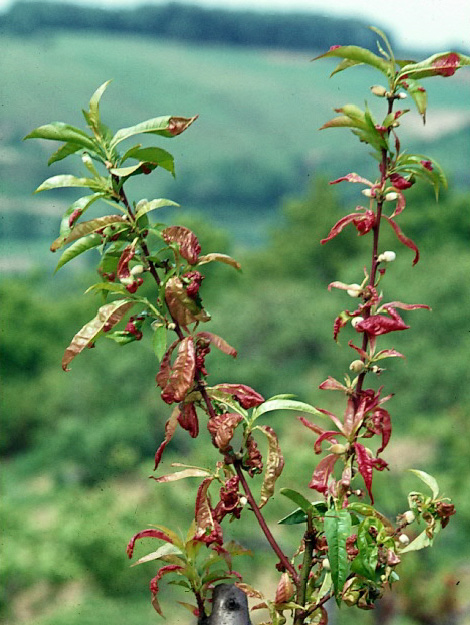Peach leaf curl
Taphrina deformans
Biology
The main overwintering quarters of the pathogen are the surfaces of twigs and bud scales. From there, the fungus is washed onto the sprouting leaves by precipitation in spring. The fungus penetrates the leaf and causes the deformations typical of curl disease. Numerous tubular bodies form on the damaged leaves, which burst open and release tubular spores, which in turn reach the shoots (= winter quarters).
A new, later shoot usually remains healthy and therefore symptomless, since the fungus does not form any further spores in the same year.
Damage symptoms
Shortly after budding, blistered distensions and yellow to reddish curling of the leaves become visible. The leaves are often erect, brittle and greatly enlarged. A white, velvety coating develops on the damaged areas. Heavily infested leaves dry out and are shed. Less frequently, symptoms are observed on the peaches (greenish to red discoloration, fruit deformation).

Prevention and control
- Use of plant protection products: this aims to break the chain of infection of the fungus during the dormancy of the tree. Copper preparations (long duration of action) or synthetic fungicides (see list of plant protection products approved in Austria) should therefore definitely be used before bud swell. Care should be taken to ensure that there are no gaps in the coating.
- If the treatment is followed by a dry, warm weather period (during which no infections can take place), the use of synthetic preparations should be repeated before precipitation. Treatments after infection has occurred are ineffective.
- Note: Infections can occur as early as January during mild weather followed by precipitation.
- Variety selection: Nectarine and yellow-fleshed peach varieties are particularly susceptible to this disease. White-fleshed varieties and many vineyard peach varieties are more tolerant.
Last updated: 05.09.2024
automatically translated